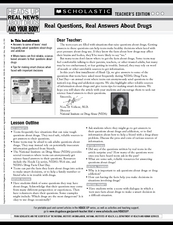Curated OER
This Is Your Brain on Pot
Students explore the causes and effects of marijuana addiction and research how THC affects different areas of the brain. They synthesize their knowledge by creating print advertisements that inform teenagers about the physiologic danger...
Scholastic
Real Questions, Real Answers About Drugs
Students brainstorm about questions they have about drugs. For this health science lesson, students research about frequently asked questions on drugs and addiction. They explain why it is important to get accurate information.
University of Minnesota
Dendritic Spines Lab
This is your brain on drugs ... literally! Your neuroscientists-in-training examine the evidence of drug use on the human brain and how neurons change their connectivity when altered by drugs. They then work together to create testing...
Florida Department of Health
Understanding the Risk of Substance Abuse Unit
Teenage brains are different! Understanding that the teenage brain is still developing and thus more impacted by substance abuse is the key concept in a three-lesson high school health unit. Participants learn about how the brain and...
Curated OER
Acting Out
Sixth graders investigate peer pressure, gangs, drinking, and using drugs. In small groups, they conduct research, develop, edit, and write a three-minute script, and perform the script for the class.
Curated OER
Under the Influence
Students examine the effects of teen drinking. In this personal health lesson plan, students research alcohol's effect on the teen brain. Students discuss their findings about the alcohol-brain connection and create brain maps.
Curated OER
Constant Craving
Students experience the effect of sensory stimulation through a guided visualization. They explore possible genetic relationships between drug addiction and the nervous system by reading and discussing, "Genetic Studies Promise a Path to...
Curated OER
Inside Story: Your Body, Your Health
Young scholars research about different genetic disorders. In this biology lesson, students create a poster highlighting facts about the disorder. They present their findings in class.







